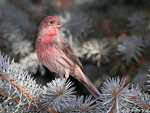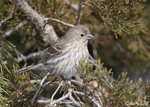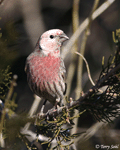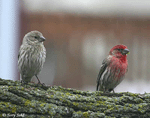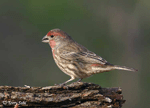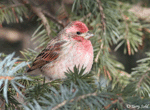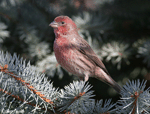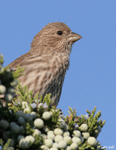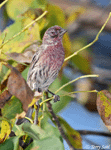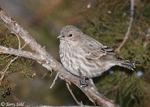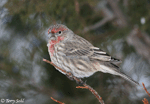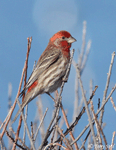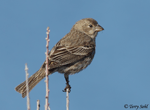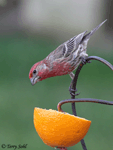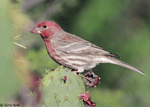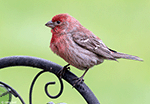| Length: 6 inches | Wingspan: 10 inches | Seasonality: All Seasons |
| ID Keys: Compare with Purple Finch. Male has red throat and chest, much of head, stripes on side. Females grayish-brown upperparts, streaked underparts. | ||
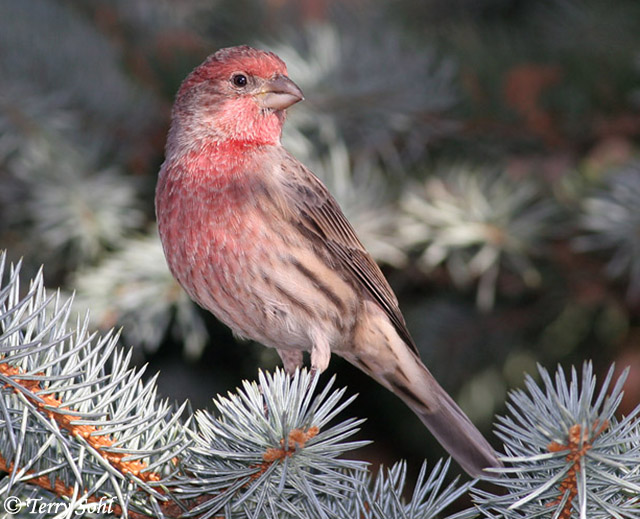 House finches are natives of the American West, but were
introduced in New York City in the 1940's. Since that time, eastern birds
have spread throughout the eastern half of the country, while western
populations have also expanded. The House Finch, like the House
Sparrow, is well adapted to living with humans and has taken advantage of
their presence rather than suffering because of it. Today the House Finch
can be found throughout the country.
House finches are natives of the American West, but were
introduced in New York City in the 1940's. Since that time, eastern birds
have spread throughout the eastern half of the country, while western
populations have also expanded. The House Finch, like the House
Sparrow, is well adapted to living with humans and has taken advantage of
their presence rather than suffering because of it. Today the House Finch
can be found throughout the country.
Habitat:
Primarily found in conjunction with human presence, around residential areas, parks, and farms.
Diet:
House Finches feed almost exclusively on vegetable matter, primarily seeds, but they will also feed on fruits and berries, buds, and flowers.
Behavior:
Will forage on the ground, in shrubs and low vegetation, or higher in trees. House Finches are gregarious, and outside of the nesting season, are often found foraging in small flocks.
Nesting:
May and June. The nest of a House Finch is a small cup of grasses, weedstems, roots, leaves, and often, bits of string, hair, or whatever other fine material may be available. The nest may be placed in an incredibly wide array of locations, depending on what's available at a given locality. It's often in a tree or shrub, but could also be on a human structure, a rocky wall, or nearly any man-made or natural structure that can support it. The female lays between 2 and 6 eggs, and she alone incubates the eggs. The young hatch after about 12 to 14 days, with young fledging from the nest about 12 to 16 days from hatching. Depending upon local conditions, nesting pairs may raise more than one brood in a given season.
Song:
The song of a House Finch is a rambling jumble of notes, with males frequently singing, and females sometimes singing shorter versions of the same song. The call of a House finch is a crisp cheep.
- Click here to hear the song of a House Finch1
- Click here to hear the call of a House Finch2
- Click here to hear the calls of an adult House finch and begging calls of its young3
Migration:
Generally a permanent resident, although some higher-elevation populations will move downslope in winter, and some northerly populations will migrate southward.
Interactive eBird Map:
Click here to access an interactive eBird map of House Finch sightings
Similar Species:
House Finch are similar to multiple other small finch species that are present in South Dakota at certain times of year. Here are the species most likely to be confused with a House Finch:
- Purple Finch - Purple Finches are winter visitors to South Dakota, primarily in the eastern part of the state, where they may be present in good numbers some winters, and relativeliy absent in other winters. They are very similar to House Finch, and will often attend feeders alongside them, resulting in identification challenges. Both male and female Purple Finch could potentially be confused with a House Finch. Click here to see a page dedicated to differentiating between House Finch and Purple Finch.
- Cassin's Finch - Cassin's Finch are a species of western North America, and in South Dakota, the vast majority are found in the Black Hills. Both males and females are similar in appearance to House Finch. Male Cassin's Finch have a bright reddish crown, while the head of a male House Finch is rounded without a crown. Male Cassin's Finch also are less heaviliy streaked on the flanks than a male House Finch, with a generally "clean" appearance on their belly and underside. Females of the two species are very similar, but female Cassin's Finch appear to have finer, better defined streaking than the more diffuse, blurry streaking on a female House Finch.
- Pine Siskin - Male House Finch aren't likely to be confused with Pine Siskins, as the reddish tones on a male House Finch are completely absent on Pine Siskins. However, they are a streaked finch that could easily be confused with a female House Finch. Pine Siskins have a variable amount of yellow edging on the wings and upper tail feathers that is lacking from female House Finch. They also have a finer, more sharply conical bill than the heavier, more curved bill of a female House Finch.
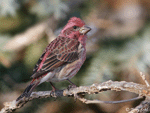 |
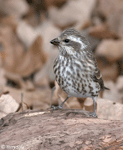 |
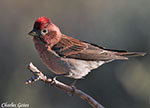 |
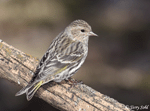 |
| Purple Finch (male) | Purple Finch (female) | Cassin's Finch | Pine Siskin |
Conservation Status:
Systematic surveys in recent decades have shown large increases in overall House Finch numbers, as well as a range expansion. They are found across an extremely broad geographic area, and they are very common in parts of that range. The IUCN considers the House Finch to be a species of "Least Concern".
Bird Feeders:
House Finches will attend feeders for a wide variety of food items, incluiding sunflower seeds, thistle, and millet seeds.
Birdhouses:
Will nest in appropriately sized houses and boxes. Here is information from NestWatch on proper nest box construction and placement to attract House Finch.
Further Information:
- USGS Patuxent Bird Identification InfoCenter, House Finch
- House Finch - Audubon Guide
- WhatBird - House Finch
Photo Information:
April 19th, 2003 - Our house in Brandon, South Dakota - Terry Sohl
Additional Photos:
Click on the image chips or text links below for additional, higher-resolution House Finch photos.
Audio File Credits:
- 1Ted Floyd. Recorded in Boulder County, Colorado on February 19th, 2021. Original recording and information available from xeno-canto.
- 2Manuel Grosselet. Recorded in Sinaloa, Mexico on July 2nd, 2020. Original recording and information available from xeno-canto.
- 3Paul Marvin. Recorded in San Diego County, California on April 24th, 2020 . Original recording and information available from xeno-canto.
| Click on the map below for a higher-resolution view |
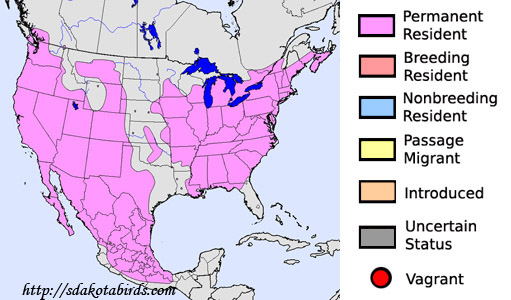 |
| South Dakota Status: Common permanent resident throughout South Dakota (Natureserve data above not locally accurate in South Dakota). |
Additional House Finch Photos
Click for a higher-resolution version of these photos
